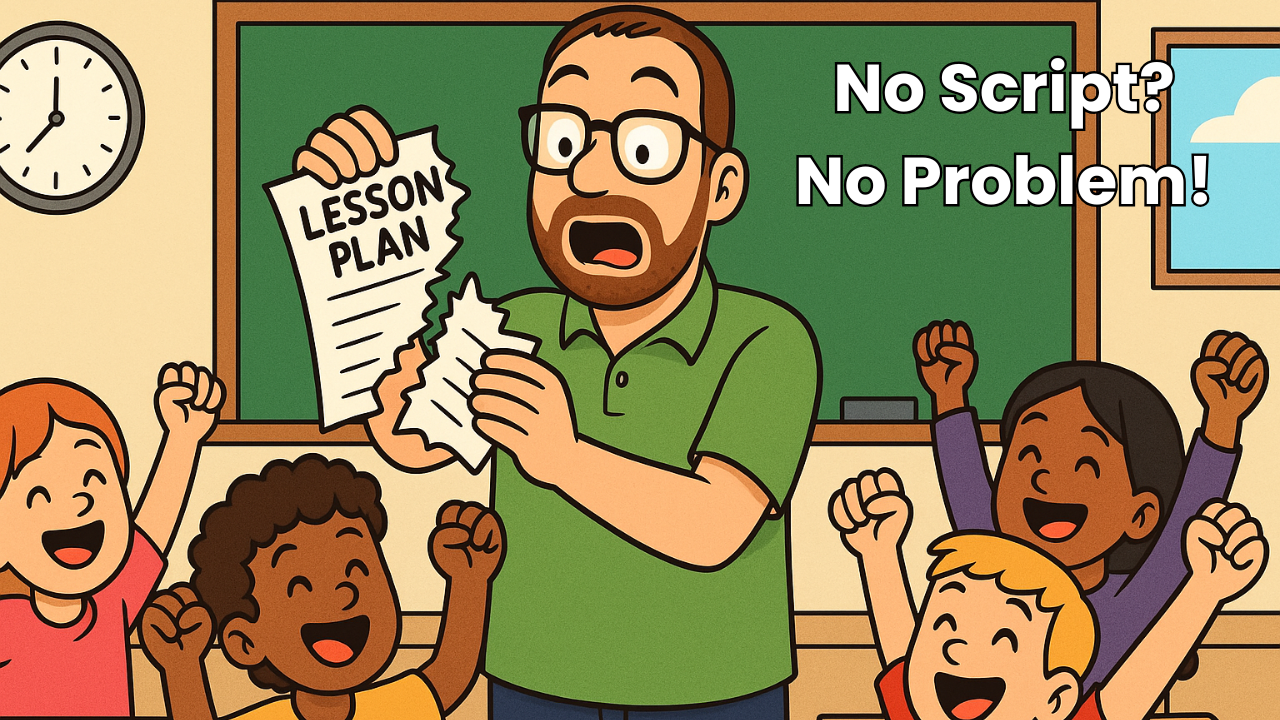
Introduction: Wait… I Don’t Need a Script?!
There comes a moment in every language teacher’s life—usually around the 37th time you’ve reprinted a lesson plan or watched a kid eat your “emergency” chocolate stash—when you ask yourself:
"Do I really need to plan every. single. word. I say in class?"
Spoiler alert: You don’t.
In fact, teaching without a script might be the most freeing, flexible, and freakishly effective decision you’ll ever make. And no, this isn’t just for the veteran teachers who can improvise a novella with a dry-erase marker and a sock puppet. This is for you. Yes, you—new, nervous, spreadsheet-loving, or flying-by-the-seat-of-your-polyester-pants.
CI teaching thrives on interaction, connection, and input students actually care about. That means letting go of the rigid plan, embracing spontaneity, and showing up like the glorious, off-script language magician you truly are.
So if you’re ready to stop obsessing over flawless plans and start crushing it with real, unscripted teaching—grab your metaphorical cape. We’re doing this.
Part 1: Your Script Is a Security Blanket (and It’s Time to Set It Down Gently)
Let’s be honest: scripted teaching feels safe. Predictable. Like a Netflix rerun you know won’t emotionally destroy you.
But here’s the thing—students don’t connect with scripts. They connect with you. They remember the goofy faces you made when saying burro, the time you turned a grammar mistake into a ten-minute soap opera, and when you asked them if “taco” could be a personality type.
Ditching the script doesn’t mean ditching structure. It means trusting yourself to lead a conversation, adapt on the fly, and guide your students in real time.
Try this: Instead of a full lesson plan, write a single goal on the board:
“Students will understand and use ‘quiere’ in context.”
That’s it. Then ask one student what they want. Boom—now you’re off and running.
Want more structure but less scripting? Use the holy trinity: a prompt, a prop, and a plan-ish (a loose outline of 3-5 steps, not a minute-by-minute breakdown).
Trust your instincts. The kids aren’t grading your outline—they’re watching you model language in motion.
Part 2: Build Your Fallback Formula (aka Your CI Safety Net)
Okay, deep breath. You’ve thrown the script in the recycling bin. (Or burned it ceremonially—no judgment.)
Now what?
Here’s the truth: even without a script, you still need a few reliable go-to structures—but ones that are flexible, responsive, and hilarious when needed. Think of these as your CI safety net.
Let’s build your fallback formula.
1. The "Start with a Student" Strategy
Choose one student. Ask about their weekend, breakfast, mood, or sock color. Respond with over-the-top interest. Expand it into a class-wide conversation. You now have a 15-minute CI experience born from someone's oatmeal.
2. Picture Prompts with Zero Prep
Google Image Search. One word. Project the weirdest image. Ask: What is happening here? Who is this person? What’s in that taco? Suddenly, you’re narrating a dramatic scene involving an emotional llama at a birthday party.
3. The Prop Drop
Keep three ridiculous props on hand: sunglasses, a stuffed animal, and a mysterious “box.” Ask who each item belongs to. Invent wild stories. Students will invent with you.
None of this requires a script. Just a starting point and a willingness to play.
Part 3: Dramatic Teaching = Memorable Input
Your CI classroom is not a boardroom. It’s a theatrical production with popcorn-level storytelling and a dash of chaos.
When you teach off-script, you’re free to become the over-the-top, mildly ridiculous, wildly effective narrator your students actually remember.
Here’s how to make it work:
React like you’re in a telenovela.
Student: “I want a pet raccoon.”
You: (gasps, clutches pearls) “¿¡UN MAPACHE!?”
You’ve just reinforced vocabulary and hooked their attention.
Use suspense like a Netflix series finale.
Build to a cliffhanger in your story. “But THEN… the door creaked open… and… ¡Fin! See you tomorrow.”
Act out everything. Yes, everything.
You don’t need Broadway training. Just flap your arms when saying “volar” and pretend the whiteboard is attacking you during “luchar.” Students don’t forget it.
Why does this work? Because input that’s funny and emotionally charged sticks. Your brain loves drama. Use it.
Part 4: Lean Into Spontaneity (and Embrace the Awkward)
Teaching off-script isn’t about perfection. It’s about connection—and sometimes that means awkward silence, tech fails, or a complete story detour because someone brought a hamster to class.
When that happens, lean in.
Did your activity crash and burn? Great. Narrate the disaster in the target language. “The teacher wanted to use Quizlet… but Quizlet said NO.”
Did a student say something wild? Even better. Follow that tangent. “So… you’re telling me your uncle owns a spaceship?” Run with it. Suddenly, you’re 12 minutes deep into a story about Martian salsa dancers.
Did your brain just forget the word for ‘chair’? Pause. Look at the class. “¿Cómo se dice ‘chair’? Ayúdame…” Let students save you. They love it.
These moments aren’t mistakes. They’re gold. They show students that language is a living, breathing thing, not a fill-in-the-blank worksheet.
Part 5: Prepare Less. Connect More. (Seriously, It's Fine.)
The real magic of teaching without a script? You spend less time planning and more time actually interacting with your students. Imagine that.
You stop obsessing over transitions and start noticing when your quiet student finally uses a full sentence. You stop flipping through binders and start asking real questions. You stop teaching content and start teaching humans.
Want to prep for tomorrow’s class? Try this instead of your usual 47-slide deck:
- Think of one fun question to ask your class.
- Pick one high-frequency verb to focus on.
- Grab one weird object to use.
Done. That’s your “plan.”
CI teaching doesn’t reward the most organized teacher. It rewards the most responsive one.
So loosen your grip. Laugh a little more. Let your students surprise you. And remember: if you’re making comprehensible input happen, you’re already crushing it.
Conclusion: You’re More Prepared Than You Think
Teaching without a script isn’t reckless. It’s revolutionary.
It’s trusting that your instincts, your humor, your ability to connect, and your students' curiosity are enough to drive real language acquisition. It’s throwing away the illusion of control and replacing it with actual learning.
You won’t get it perfect every time—and that’s the point. This isn’t about perfection. It’s about presence.
So next time you feel that panic rising because you forgot your plan, remember:
You’ve got a brain, a story, a whiteboard marker, and at least one student who thinks llamas are funny.
You’re good to go.
🔥 Want to Know If You're Really CI-Ready?
Take the CI Proficiency Quiz to assess where you are on your journey—from newbie to ninja. It’s fast, fun, and packed with insights.
And if you’re ready to go deeper, get structured support, and actually enjoy teaching again, enroll in the Back-to-School Bootcamp at https://imim.us/bootcamp.
Use BOOTCAMP25 for $20 off. Let’s make this year your best one yet.
5 Key Takeaways
- Scripts are optional. Trust your ability to guide conversation and input on the fly.
- Use fallback routines. A prompt, a prop, and a plan-ish will carry you further than a script ever will.
- Make it dramatic. Emotions + humor = sticky input your students actually remember.
- Lean into the mess. Mistakes, tangents, and chaos aren’t bugs—they’re features.
- Connect over content. You don’t need a perfect plan. You just need to be present, human, and comprehensible.



